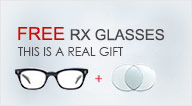- How to Find Right Glasses that Fit You (Useful:0)
- How to Order Prescription Glasses online? (Useful:129)
- Shipping & Delivery (Useful:118)
- Invite a friend,share Coupons & 20% off.
- Loading...
 FinestGlasses.comShopping Guide | finestglasses.com
FinestGlasses.comShopping Guide | finestglasses.com- M-F: 8AM - 5PM PST 626-739-3688
- Free Shipping For Over $60 (Glasses Frames + Lenses Only)/ Contact Us / Help / How to choose the right lens?
















